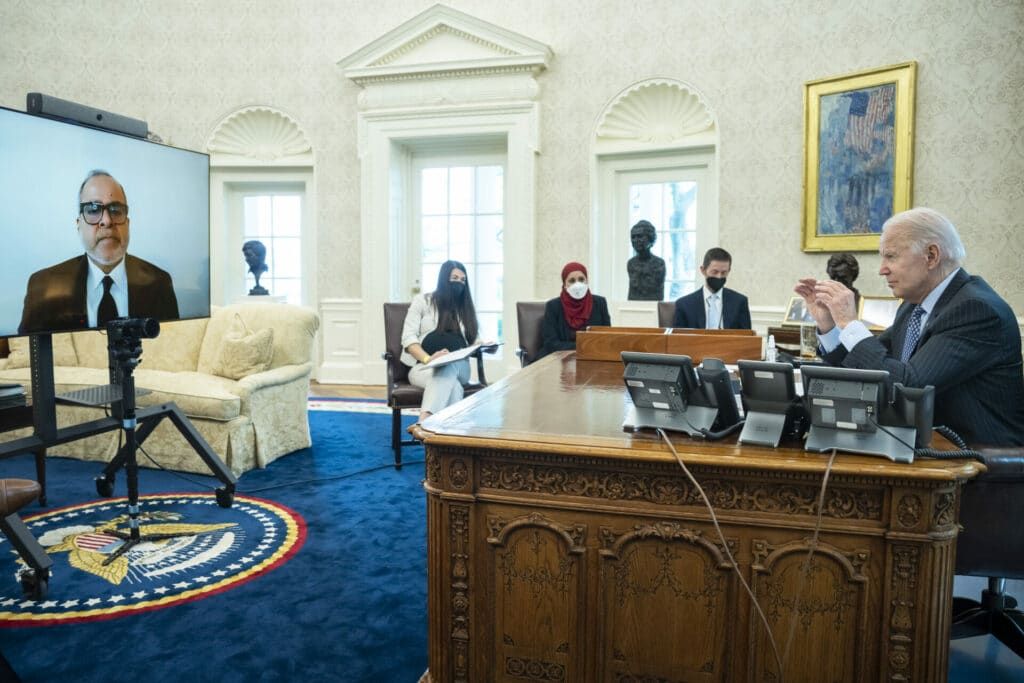Everyman Joe Biden catches COVID, just like everybody else
By Matt Field | July 21, 2022
 President Joe Biden holds a virtual meeting in May. Credit: Adam Schultz/Official White House Photo.
President Joe Biden holds a virtual meeting in May. Credit: Adam Schultz/Official White House Photo.
These days it seems like everyone is getting COVID, even President Joe Biden. If you missed the news, it’s understandable. By mid-morning Thursday, hours after the news broke, you had to scroll down a bit on The Washington Post’s website to see the headline. Because he’s 79, the president is at higher risk of severe consequences of the coronavirus than younger people, but the White House says he is so far experiencing only mild symptoms—a runny nose, cough, and tiredness. He’ll be taking calls in isolation.
When former president Donald Trump caught COVID on the campaign trail, the media coverage was wall-to-wall. The subtext to the reports about Trump’s symptoms—which made him gravely ill in the days before vaccines—was that a president who’d spent months downplaying the threat of COVID and holding massive super spreading rallies caught the virus because of his personal failings: Trump got COVID because he wasn’t doing any of the things necessary to not get it.
Now, few people or government agencies are doing or requiring those things.
The polling firm IPSOS reported this month that just two in five respondents to a recent poll said they wore a mask outside of their houses, the lowest figure of the pandemic. The CDC slashed its isolation guidelines from 10 days to five. And few state or local governments have left many mitigation measures in place. In fact, Hawaii just announced it would end the last statewide school mask mandate in the country.
Folks, I'm doing great. Thanks for your concern. Just called Senator Casey, Congressman Cartwright, and Mayor Cognetti (and my Scranton cousins!) to send my regrets for missing our event today.
Keeping busy! pic.twitter.com/uf7AsOg571
— President Biden (@POTUS) July 21, 2022
The Washington Post reports that Biden has dropped his guard in recent months:
“Throughout his presidency, Biden has taken precautions, including holding meetings via Zoom, wearing a mask during close encounters and conducting gatherings in a socially distanced manner. But the precautions were relaxed somewhat as the pandemic has begun to recede.”
Certainly, COVID is less of a threat than it was in 2020. Hospitalizations and deaths are rising, but they remain far below their peaks in previous waves. And by now most people have had COVID. The CDC estimated this spring that 60 percent of people in the United States had been infected. Familiarity has a way of breeding complacency.
But health experts have been tweeting their fingers raw that the pandemic is not over. A high number of infections, even with a milder virus, can cause a lot of hospitalizations and deaths. High caseloads also give the virus more opportunities to evolve, potentially into more dangerous variants. Already since the first omicron variant was reported last November, at least three more versions of omicron, or subvariants, have caused global case spikes. It’s gotten to the point where epidemiological charts are showing a plateau of cases as one wave crashes at the same time another rises. Then there’s long COVID. Nearly one in five US adults who’ve recovered from the acute disease reported lingering symptoms, a recent government study found. That means millions could continue to suffer from fatigue, pain, and even heart or neurological problems for months or years to come.
Biden says he’s fine. The bigger question is: are we?
Together, we make the world safer.
The Bulletin elevates expert voices above the noise. But as an independent nonprofit organization, our operations depend on the support of readers like you. Help us continue to deliver quality journalism that holds leaders accountable. Your support of our work at any level is important. In return, we promise our coverage will be understandable, influential, vigilant, solution-oriented, and fair-minded. Together we can make a difference.
Keywords: COVID-19, Joe Biden
Topics: Biosecurity














